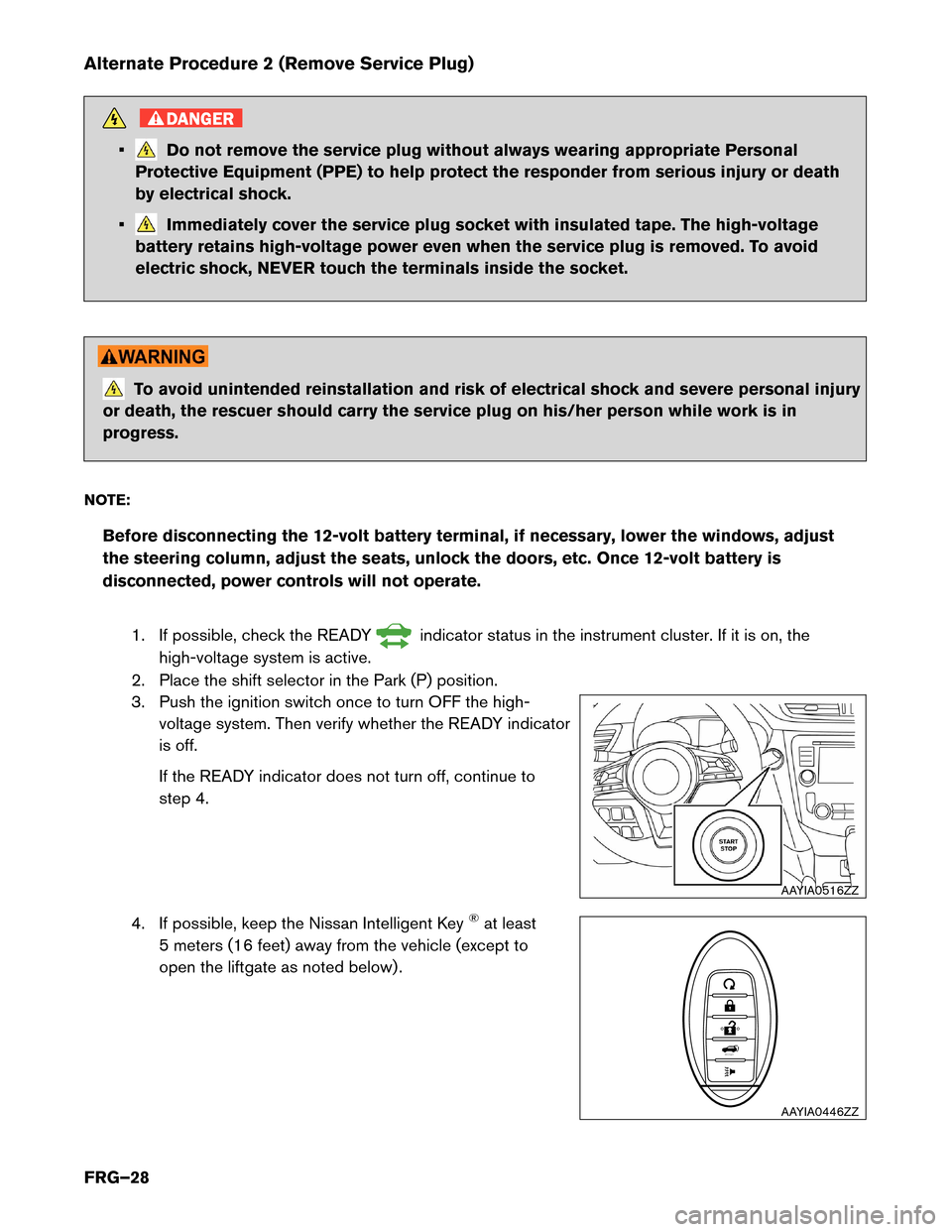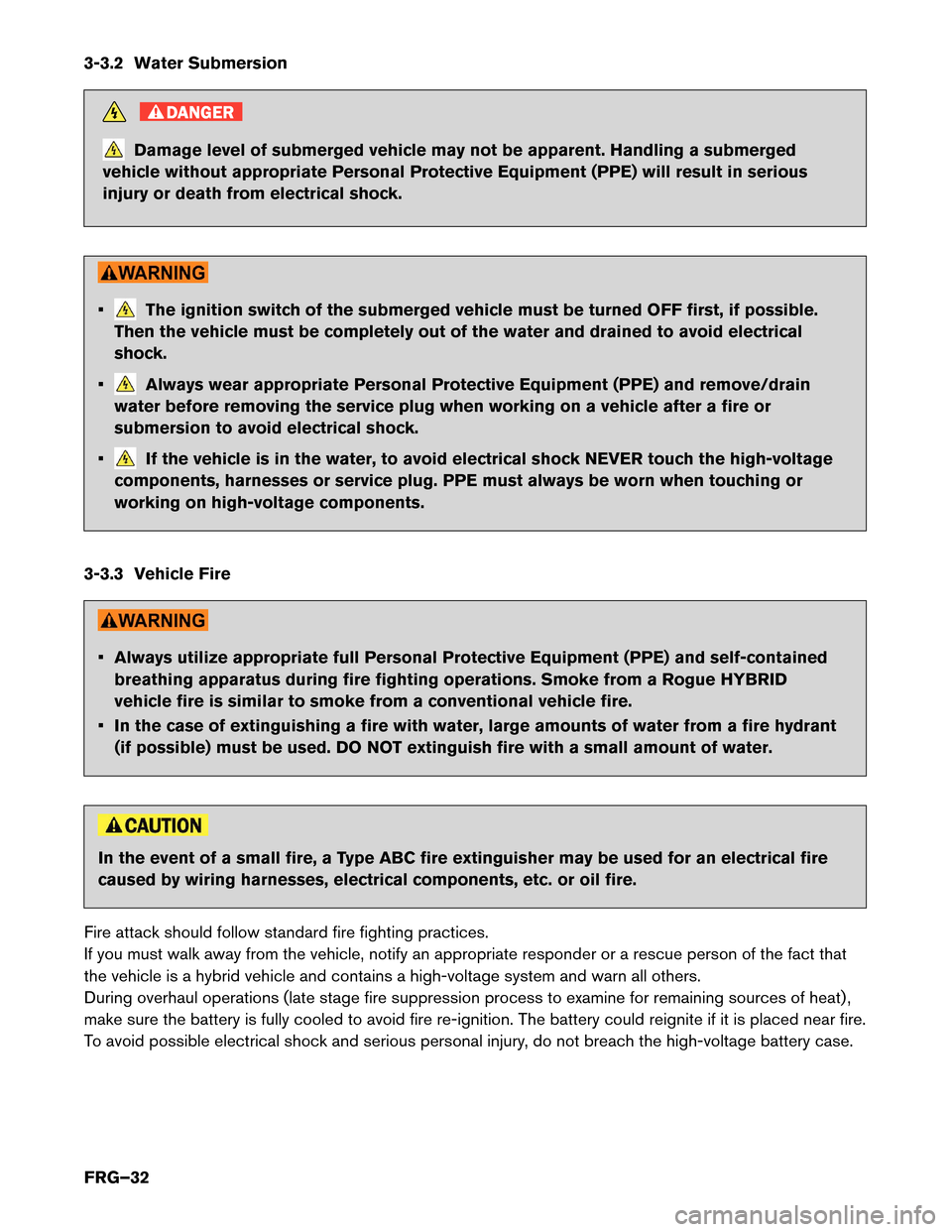Page 25 of 46
8. Disconnect negative (-) battery cable and cover it with
insulated tape.
9. Wait approximately ten (10) minutes for complete discharge of the high-voltage capacitor
after the battery cable has been disconnected.
10. Perform the first response action.
Alternate Procedure 1 (Remove Fuses)
NOTE: Before removing any fuses, if necessary, lower the windows, adjust the steering column,
adjust the seats, unlock the doors, etc. Once fuses are removed, power controls will not
operate.
1. Pull release handle located on the instrument panel and push the release lever under the hoodsideways to open hood.
2. Release clips on the narrow ends of the fuse box cover and remove it. : Vehicle front AAYIA0538ZZ
AAYIA0539ZZ
AAYIA0540ZZ
FRG–25
Page 26 of 46
3. Remove IGCT RLY fuse (F/L 50A IGCT RLY) .
: Vehicle front
4.
If you cannot identify the correct fuse, remove all the
fuses. To avoid unintended reinstallation and risk of
electrical
shock and severe personal injury or death, the
rescuer should carry the fuse or fuses on his/her person
and cover the fuse box with insulated tape.
5. Open luggage compartment, release the 2 push pin retainers (A)and lift rear luggage board.
Detach the 2 straps (B)and remove the rear luggage board.
6. Access the 12-volt battery using the following steps: a. Remove the 2 push pin retainers (A). AAYIA0176GB
AAYIA0535ZZ
AAYIA0522ZZ
FRG–26
Page 27 of 46
b. Lift front luggage board
(1), slide toward rear of
vehicle (2)and remove.
7. Disconnect negative (-) battery cable and cover it with insulated tape.
8. Wait approximately ten (10) minutes for complete discharge of the high-voltage capacitor
after the fuse panel and battery cable have been disconnected.
9. Perform the first response action. AAYIA0523ZZ
AAYIA0538ZZ
FRG–27
Page 28 of 46

Alternate Procedure 2 (Remove Service Plug)
DANGER
• Do not remove the service plug without always wearing appropriate Personal
Protective Equipment (PPE) to help protect the responder from serious injury or death
by electrical shock.
• Immediately cover the service plug socket with insulated tape. The high-voltage
battery
retains high-voltage power even when the service plug is removed. To avoid
electric shock, NEVER touch the terminals inside the socket. To avoid unintended reinstallation and risk of electrical shock and severe personal injury
or
death, the rescuer should carry the service plug on his/her person while work is in
progress.
NOTE: Before disconnecting the 12-volt battery terminal, if necessary, lower the windows, adjust
the steering column, adjust the seats, unlock the doors, etc. Once 12-volt battery is
disconnected, power controls will not operate.
1. If possible, check the READY indicator status in the instrument cluster. If it is on, the
high-voltage
system is active.
2. Place the shift selector in the Park (P) position.
3. Push the ignition switch once to turn OFF the high- voltage system. Then verify whether the READY indicator
is off.
If the READY indicator does not turn off, continue to
step 4.
4. If possible, keep the Nissan Intelligent Key
®at least
5 meters (16 feet) away from the vehicle (except to
open the liftgate as noted below) . AAYIA0516ZZ
HOLD
AAYIA0446ZZ
FRG–28
Page 29 of 46
5. Open the liftgate using any of the following*1:
a. Liftgate opener switch*2(A) (located near
bottom of liftgate) .
b. Instrument panel switch on the lower LH side of the instrument panel (If equipped) .
c. Liftgate button on the Nissan Intelligent Key
®
(button must be held for more than 0.5 second) .
d. If the liftgate cannot be opened with the liftgate opener switch, instrument panel switch, or key
fob due to a discharged battery, follow these
steps:
• From inside the vehicle, Insert a suitable toolin the top access opening hole.
• Move the release lever to the right to unlatch the liftgate and push the liftgate open.
*1: To operate the liftgate, the shift lever must be in P (Park) . Also, the power liftgate will
not operate if the battery voltage is low.
*2: You must have the Nissan Intelligent Key®within approximately 1 meter (3 feet)
range of liftgate opener switch to use the liftgate opener switch function. AAYIA0517ZZ
AAYIA0518ZZ
AAYIA0519ZZ
AAYIA0520ZZ
FRG–29
Page 30 of 46
6. Open luggage compartment, release the 2 push pin retainers
(A)and lift rear luggage board.
Detach the 2 straps (B)and remove the rear luggage board.
7. Use a suitable tool (A)to release the locking tabs and
remove the service plug access cover.
8. Remove the service plug (A)by pulling the locking lever (B), then pressing the locking tab (C)
and rotating the handle (D)fully outward. Using the handle, pull the service plug (E)completely
out of its socket.
9. Wait approximately ten (10) minutes for complete discharge of the high-voltage capacitor
after the service plug has been removed. AAYIA0535ZZ
AAYIA0525ZZ
AAYIA0536ZZ
FRG–30
Page 31 of 46
10. Access the 12-volt battery using the following steps:
a. Remove the 2 push pin retainers (A).
b. Lift front luggage board (1), slide toward rear of
vehicle (2)and remove.
11. Disconnect negative (-) battery cable and cover it with insulated tape.
12. Perform the first response action. AAYIA0522ZZ
AAYIA0523ZZ
AAYIA0538ZZ
FRG–31
Page 32 of 46

3-3.2 Water Submersion
DANGER
Damage level of submerged vehicle may not be apparent. Handling a submerged
vehicle without appropriate Personal Protective Equipment (PPE) will result in serious
injury or death from electrical shock. • The ignition switch of the submerged vehicle must be turned OFF first, if possible.
Then
the vehicle must be completely out of the water and drained to avoid electrical
shock.
• Always wear appropriate Personal Protective Equipment (PPE) and remove/drain
water
before removing the service plug when working on a vehicle after a fire or
submersion to avoid electrical shock.
• If the vehicle is in the water, to avoid electrical shock NEVER touch the high-voltage
components,
harnesses or service plug. PPE must always be worn when touching or
working on high-voltage components.
3-3.3 Vehicle Fire • Always utilize appropriate full Personal Protective Equipment (PPE) and self-contained
breathing
apparatus during fire fighting operations. Smoke from a Rogue HYBRID
vehicle fire is similar to smoke from a conventional vehicle fire.
• In the case of extinguishing a fire with water, large amounts of water from a fire hydrant (if possible) must be used. DO NOT extinguish fire with a small amount of water. In the event of a small fire, a Type ABC fire extinguisher may be used for an electrical fire
caused
by wiring harnesses, electrical components, etc. or oil fire.
Fire attack should follow standard fire fighting practices.
If you must walk away from the vehicle, notify an appropriate responder or a rescue person of the fact that
the vehicle is a hybrid vehicle and contains a high-voltage system and warn all others.
During overhaul operations (late stage fire suppression process to examine for remaining sources of heat) ,
make sure the battery is fully cooled to avoid fire re-ignition. The battery could reignite if it is placed near fire.
To avoid possible electrical shock and serious personal injury, do not breach the high-voltage battery case.
FRG–32